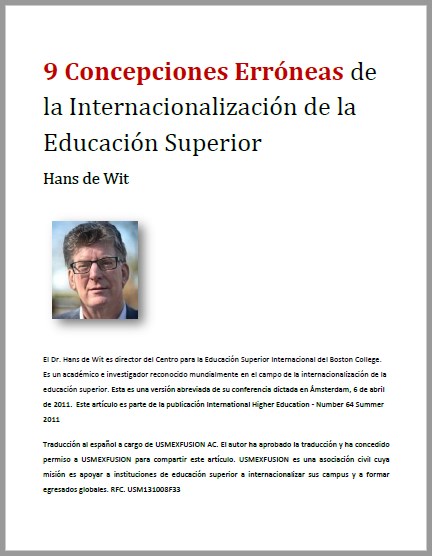Elements of Comprehensive Internationalization - Si3 USMEXFUSION
Category Si3 English Date 2016-01-12 10:43:12 2114 Vistas
http://usmexfusion.org/en/Si3/
Dr. Donald Mathews, Former Associate Vice President for Global Ed and Affairs at Daytona State College, and USMEXFUSION’s lead Expert and Coach in Institutional Internationalization asserts that the important elements of institutional internationalization are:
Comprehensive Strategic Planning
Institution wide (cooperation)
Curriculum
Study Abroad
Professional Development
Foreign Language Acquisition
And Identifying funding for International activities
Is your institution currently working in any of these areas? Let’s look at each of the elements a little more closely…
Comprehensive Internationalization Strategic Planning
For the planning in this area, it is important to include key international and intercultural concepts in the Mission, Vision and Values of the institution.
There are two types of CI strategic plans:
An additional CI Institutional Strategic Plan can be created, which would run parallel to the existing institutional strategic plan.
OR, a NEW Institutional Strategic Plan can be created, which would include CI as an over-arching theme through all sectors of the institution.
Institution wide
Institution wide means that in the process of internationalization, it is imperative to involve ALL members of the institution. Everyone needs to be invested in this process for it to be successful. This includes EVERY employee, including the president, academic deans, coordinators, faculty, staff,
Students, Graduates,
AND it is also of key importance to involve local and regional stakeholders from the Public, Private and Social sectors.
Curriculum
Betty Leask (2009) believes that “Internationalization of the curriculum is the incorporation of an international and intercultural dimension into the preparation, delivery and outcomes of a program of study. An internationalized curriculum purposefully develops all students’ international and intercultural perspectives as global professionals and citizens.”
Study Abroad
It is important to have clear mobility purposes. Ideally, the mobility experience of staff and students not only benefits them but also benefits their academic programs, their institution, their community and the international community.
Professional Development
As we mentioned, in the process of institutional internationalization, it is imperative to continuously raise awareness and offer professional development training to ALL members of the institution. This means EVERY employee, including the president, deans, coordinators, faculty and staff,
Students and Graduates, AND again, it is also of key importance to include local and regional stakeholders from the Public, Private and Social sectors and to offer them professional development training in CI as well.
Foreign Language Acquisition
It is important to develop foreign language capacity at your institution, with students reaching at least the B2 level of the Common European Framework of Reference for Languages, or an upper-intermediate level. This level of foreign language acquisition should be strived for not only in students, but in personnel as well! Your institution should offer two or more foreign languages, depending on local and regional needs, AND you should consider offering classes of a native or indigenous language.
The final element is an important and sometimes difficult task. It is to identify funding for international activities. This includes raising funds from the public, private and social sectors, both nationally and internationally.
To learn more about the elements of institutional internationalization, we recommend our video showcasing CCID’s Framework for Comprehensive Internationalization. You can find it on our website.
The Framework contains 10 broad categories, each one with specific subcategories and their corresponding institutional internationalization development stages.
You can download the full version of CCID’s Framework for Comprehensive Internationalization in Spanish on this webpage. If you would like a copy in English, please contact CCID directly. We thank CCID for its generosity and global commitment to allow the Spanish version of its Framework for INTZ available through USMEXFUSION.
If you would like to know more about how to implement Si3 in your institution, you are welcome to visit our website usmexfusion.org and to have open access to videos that will assist you in advancing the Comprehensive internationalization of your campus. Thank you for your attention.
Academia En Línea
Contáctenos
English Tel. MX +52 238 335 7417
Español Tel. MX +52 238 335 7417

Descargue este artículo ingresando su email abajo. Recibirá otros recursos útiles.
